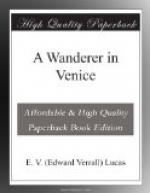Not much is known of the life of Paolo Caliari of Verona. The son of a stone-cutter, he was born in 1528, and thus was younger than Titian and Tintoretto, with whom he was eternally to rank, who were born respectively in 1477 or 1487 and 1518. At the age of twenty-seven, Veronese went to Venice, and there he remained, with brief absences, for the rest of his life, full of work and honour. His first success came when he competed for the decoration of the ceiling of S. Mark’s library and won. In 1560 he visited Rome in the Ambassador’s service; in 1565 he married a Veronese woman. He died in 1588, leaving two painter sons. Vasari, who preferred Tuscans, merely mentions him.
More than any other painter, except possibly Velasquez, Veronese strikes the observer as an aristocrat. Everything that he did had a certain aloofness and distinction. In drawing, no Venetian was his superior, not even Tintoretto; and his colour, peculiarly his own, is characterized by a certain aureous splendour, as though he mixed gold with all his paints. Tintoretto and he, though latterly, in Titian’s very old age, rivals, were close friends.
Veronese is the glory of this church, for it possesses not only his ashes but some fine works. It is a pity that the light is not good. The choir altar-piece is his and his also are the pictures of the martyrdom of S. Sebastian, S. Mark, and S. Marcellinus. They are vigorous and typical, but tell their stories none too well. Veronese painted also the ceiling, the organ, and other altar-pieces, and a bust of him is here to show what manner of man he was.
Close to the door, on the left as you leave, is a little Titian which might be very fine after cleaning.
There are two ways of returning from S. Sebastiano to, say, the iron bridge of the Accademia. One is direct, the other indirect. Let us take the indirect one first.
[Illustration: THE PALAZZO PESARO (ORFEI), CAMPO S. BENEDETTO]
Leaving the church, you cross the bridge opposite its door and turn to the left beside the canal. At the far corner you turn into the fondamenta of the Rio di S. Margherita, which is a beautiful canal with a solitary cypress that few artists who come to Venice can resist. Keeping on the right side of the Rio di S. Margherita we come quickly to the campo of the Carmine, where another church awaits us.
S. Maria del Carmine is not beautiful, and such pictures as it possesses are only dimly visible—a “Circumcision” by Tintoretto, a Cima which looks as though it might be rather good, and four Giorgionesque scenes by Schiavone. But it has, what is rare in Venice, a bronze bas-relief from Tuscany, probably by Verrocchio and possibly by Leonardo himself. It is just inside the side door, on the right as you enter, and might easily be overlooked. Over the dead Christ bend women in grief; a younger woman stands by the cross, in agony; and in a corner are kneeling, very smug, the two donors, Federigo da Montefeltro and Battista Sforza.




